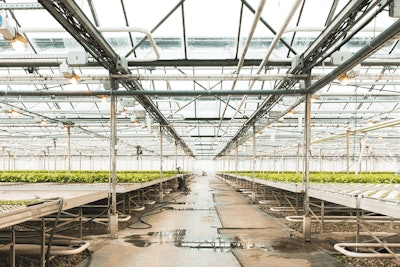
One should use a critical eye when considering an existing greenhouse for cannabis cultivation. Many were built without the need to power and support heavy light fixtures or provide clearance for overhead curtains, and often the floors and structure are not to cannabis cultivation regulation standards. Here are key considerations and questions to ask when examining the viability of an existing greenhouse:
1. Structural integrity.
It’s important to start with the foundation when examining whether to build new or retrofit, as a weak structure would quickly drive your decision toward a new build. Inspect the knee wall (low foundation wall) and cement floors for cracks. Settling foundations can put pressure on heating pipes fastened to perimeter walls, resulting in dangerous steam or hot water leaks. Older greenhouses may have steel or wood supports that rust or rot, typically where they fasten to the knee wall, due to moisture pooling. This deterioration may be covered up with layers of paint.
2. Crop History.
In a 2018 study, plant pathologists surveying Canadian cannabis greenhouses correlated the presence of disease with past crop history. Greenhouses that were used to grow tomatoes or cucumbers were more likely to have Botrytis and Penicillium, and these problems persisted and affected the new cannabis crops as pathogens remained airborne.
3. Floors.
Likewise, greenhouses with dirt or gravel floors are much more likely to have insect larvae and pupae. These insects may be “super bugs” that have resistance to pesticides from decades of routine spraying.
4. Height of sidewalls.
Greenhouse construction trends during the past decade have been to increase sidewall height, providing a larger volume of air to buffer against rapid changes in environment and room for equipment. Note these important questions: Can lights hang far enough above the canopy and not cause burn? Is there room to install light-deprivation curtains and for a second set of curtains for shade reduction in summer light?
5. Framing.
If you plan on replacing the glazing (glass, plastic or acrylic panes), are the glazing bars the correct width apart to hold the new glazing, or will they need to be completely replaced, adding to cost? If you are keeping the same glazing, does it need to be resealed to prevent leaks and insect infestation? Stand in the greenhouse during a windy rainstorm to find out.
6. Screens.
Insect screens on greenhouse openings will greatly reduce infestation, but it is difficult to retrofit an existing greenhouse with screens because they reduce air flow. To compensate for this, a large surface area can be created around the opening by building a box around intake vents or fans and using accordion-style pleated screen fabric on vents.
7. Environmental hazards.
Old greenhouses often have lead paint and asbestos requiring remediation, which isn’t a dealbreaker, but should be considered in the cost estimate and timeline.
8. Drains.
If the existing greenhouse has cement floors, where does the water drain?
9. Layout.
Does the existing greenhouse have adequate room for a loading dock and clearance for trucks? Will there be room for a security fence and a secure employee parking lot? Does the interior of the greenhouse lend itself to efficient flow of materials and labor? Can separation be achieved between plant stages?
10. Utility Costs.
Older greenhouses will not be tightly sealed, so will cost more to heat. They will cost more to control insects and disease. They may also not utilize more efficient, higher voltage supplies, so it is important to determine if the savings to retrofit now will outweigh potential higher utility costs of the future.
Read the Cultivation Startup & Expansion Guide























